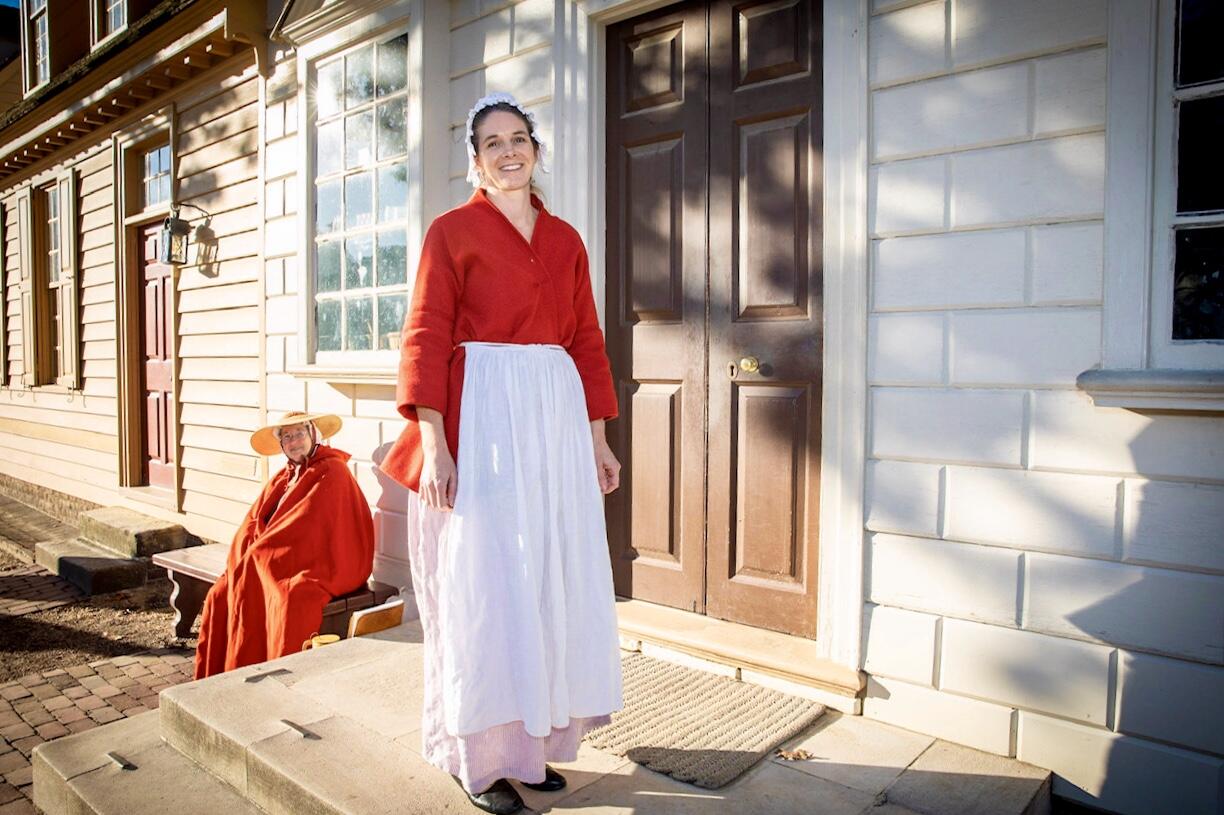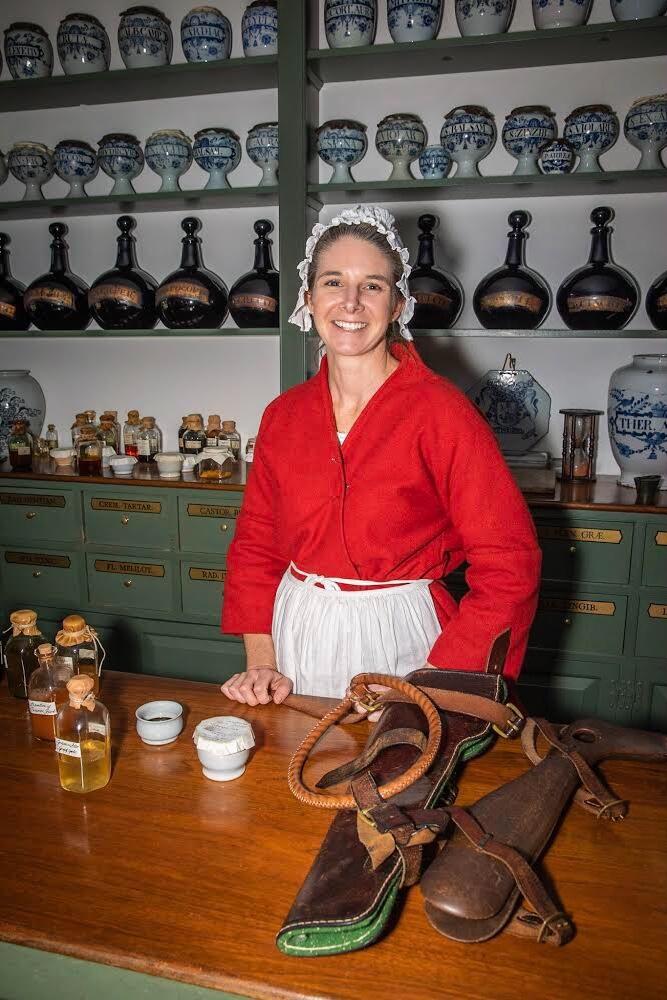
Nov. 22, 2019
Colonial Williamsburg internship gives pharmacy student a chance ‘to do something unusual’
Share this story
Mortar and pestle? All set.
Pill-rolling molds? Check.
Bonnet and corset? Check and check.
Leeches? Hold on ...
For their fourth and final year of school, Virginia Commonwealth University pharmacy students travel across the country or the world for a series of five-week internships in professional settings. They usually can expect to spend time at where pharmacists anticipate working — in hospitals, retail pharmacies, at the Food and Drug Administration, that sort of thing.
They do not expect to put on a bonnet, corset and five layers of 18th-century clothing and spend their days discussing a large jar for leeches and rolling licorice pills by hand.
Those are just some of the tasks Dena Kota just finished doing for her rotation at the Pasteur & Galt Apothecary Shop in Colonial Williamsburg.
For 40 hours a week Kota, a School of Pharmacy student, prepared examples of colonial-era medicines, pored over old medical recipes and explained to visitors the work of a druggist in the days of George Washington, Thomas Jefferson and Alexander Hamilton.
“It’s like living history,” Kota said.
The apothecary, a 20th-century reproduction of the colonial drug shop that existed at the site on Duke of Gloucester Street, sees up to 600 visitors a day, according to Colonial Williamsburg. Kota and her coworkers demonstrated and explained for them the ways an apothecary was a center of colonial life. The shop was a source of medicine, advice and everyday goods — chalky pills for heartburn, ointments and Epsom salts for aches, jars of leaves and bark for other ailments.
And everyone asked about leeches, Kota said.
Kota, who holds a Ph.D. in pharmacology and toxicology from VCU and worked in a lab for seven years before switching to pharmacy, said she was surprised to learn how much colonial druggists knew about treating patients.
Among the concoctions she prepared was a “tincture of Peruvian bark,” a common treatment for malaria using cinchona bark. Scientists later discovered that cinchona contains the antimalarial quinine.
She also dried foxglove flowers from the apothecary’s garden to make an 18th-century treatment for “dropsy,” an old term for edema or swelling of the body from retained fluid. Digitalis, found in foxglove, still is used today to treat edema caused by heart conditions.
Even those leeches, which in the colonial era were kept in a damp jar and applied to reduce blood, mostly in children, have uses today. Physicians apply them to improve blood flow to reattached body parts. In fact, in 1994 doctors in Norfolk put in an emergency call to Colonial Williamsburg’s apothecary for leeches to save a reattached ear. (The patient reported “a chewing or a sucking sound,” according to a newspaper interview.)
Though the apothecary has used history graduate students as assistants for years, it only recently began bringing in pharmacy students to specialize in the medical aspects of the apothecary’s records, said Robin Kipps, supervisor of the apothecary.
This gave VCU pharmacy students a “rare opportunity … to do something unusual” for one of their five-week rotations in their fourth year, said Denise Emminger, senior administrator experiential student affairs at the School of Pharmacy.
“It’s something they might not typically do,” she added.

Indeed, Kota was the first VCU pharmacy student and only the second pharmacy student ever to participate in the Colonial Williamsburg rotation — most of the 122 students in her fourth-year pharmacy class take part in rotations at sites such as nuclear-medicine pharmacies, retail locations, community health centers and correctional facilities.
Through studying old recipes for medications and historic apothecary records, Kipps and her team at the Colonial Williamsburg apothecary aim to understand how colonial-era people used medicine and how the wider social changes going on during the Revolutionary period affected them.
Though the medical treatments of the day were not effective in curing illness, they could be effective in treating symptoms, Kipps said. So far, the apothecary’s work has identified at least 60 colonial ingredients that improve symptoms such as fever, added Kipps, who has worked at the apothecary since 1983.
“We’re seeing that these building blocks … from the 18th century are still parts of modern pharmacy,” Kipps said.
Kota, a mother of three, grew up near Colonial Williamsburg and visited the apothecary as a child. She said her recent experience has opened her eyes to the work going on in the living museum.
Along with her shop-tending duties, she spent hours during her rotation reviewing and deciphering what the old textbooks were saying.
For example, after listing ingredients and the basic elements of a preparation, the texts often simply instructed users to “make according to art,” Kota said.
The specifics of how much to grind or boil a material often went unmentioned. That oblique approach may have been a way for druggists to protect trade secrets or it might simply have reflected the apprenticeship system of the day, Kipps said.
To figure out what the authors meant, Kota had to apply trial and error. For example, she learned that drying foxglove flowers on a countertop did not work well, while drying them in a bunch in a window did.
She also had to learn archaic forms of measurement — drams and grains rather than ounces or kilos — and got plenty of practice explaining her work to curious onlookers, which she said will be helpful in her career as a pharmacist.
The leeches, however, were less rewarding. The jar of leeches has sat on the apothecary counter for years, but in October all five of them managed to escape their jar overnight and disappeared, Kipps said. They have not been seen, and since they need constant moisture, are presumed dead.
Kipps is considering replacing them — they cost $13 apiece from a medical-supply house. But she might not, she said.
“It got to the point where visitors didn’t want to talk about anything else.”
Subscribe to VCU News
Subscribe to VCU News at newsletter.vcu.edu and receive a selection of stories, videos, photos, news clips and event listings in your inbox.



